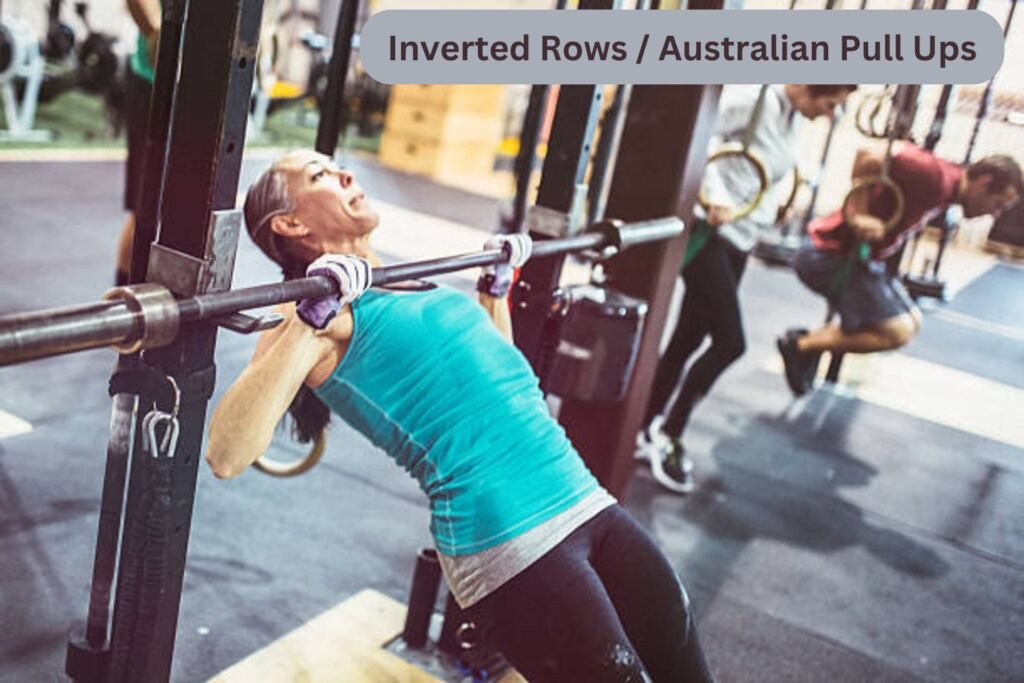Ever wondered what is an Australian Pull Up?
What if I told you that this single exercise could change your pull-up strength and drastically improve your upper body muscle definition?
It’s a game-changer that not only builds power in your back and biceps but also engages your core, making it a must-have in any serious calisthenics routine.
The Australian Pull Up—also known as the Inverted Row—is that exercise.
It’s a foundational move in calisthenics that you need to know about if you’re serious about bodyweight training.
Let’s break it down.
Why You Need the Australian Pull Up in Your Routine
Here’s the deal.
If you’ve been struggling with traditional pull-ups or just want to build a stronger, more defined upper body, the Australian Pull Up is your golden ticket.

This exercise is perfect because:
- It’s easier on the joints than regular pull-ups.
- You can adjust the difficulty, making it beginner-friendly but also challenging for seasoned athletes.
- It targets the upper back, lats, and core like nothing else.
I’ve been doing calisthenics for a decade now, and trust me, the Australian Pull Up is a game-changer.
It’s especially useful for those who can’t do a full pull-up yet but still want to build the strength necessary to get there.
How to Perform the Australian Pull Up
Let’s get into the nitty-gritty.
Performing an Australian Pull Up is straightforward, but getting it right is crucial.
Here’s how you do it:
| Step | Instruction | Tips for Execution |
|---|---|---|
| 1. Set Up Your Bar | Find a bar around waist height, or use a sturdy table at home. | Ensure the bar is secure and can hold your weight. |
| 2. Position Yourself | Lie down under the bar, grabbing it with an overhand grip. | Keep your hands shoulder-width apart. |
| 3. Engage Your Core | Maintain a straight line from head to heels. | Avoid sagging your hips to keep your core tight. |
| 4. Pull Yourself Up | Drive your elbows back, pulling your chest to the bar. | Focus on control, not speed. |
| 5. Lower Slowly | Lower yourself back to the starting position, arms fully extended. | Use slow, controlled movements to maximize muscle engagement. |
Great and clean execution in this video from Breaking Muscle.
Common Mistakes and How to Avoid Them
Here’s the thing.
You can do the Australian Pull Up wrong. And if you do, you’ll miss out on its benefits.
Here are the common pitfalls to watch out for:
- Using Momentum: If you’re swinging your body to get up, you’re not building strength. Focus on slow, controlled movements.
- Arching Your Back: Keep your core tight to avoid putting unnecessary strain on your lower back.
- Flared Elbows: Keep your elbows close to your body to engage your lats effectively.
- These mistakes are common, but easy to fix with a bit of mindfulness during your workout.
PRO TIP
Unlock exponential gains by performing Australian Pull Ups with elevated feet for an intense core challenge!
Why the Australian Pull Up is a Step-Up from the Standard Row
Let’s be real.
The standard row is great, but the Australian Pull Up is in a league of its own.
Here’s why:
- Increased Range of Motion: You’re moving through a greater range, which means more muscle activation.
- Core Engagement: Unlike the standard row, you need to engage your core constantly to keep your body straight.
- Scalability: You can easily make this exercise harder by changing the angle of your body or adding weight.
- This move isn’t just for beginners. Advanced athletes use it to refine their technique and build serious upper body strength.
Integrating the Australian Pull Up into Your Workout Routine
Now you might be wondering, “Where does this fit into my workout?”
Great question.
Here’s how you can integrate the Australian Pull Up into your routine:
Warm-Up: Start with Australian Pull Ups to activate your back and core before moving on to heavier lifts or more advanced calisthenics.
Superset with Push-Ups: Alternate between pull-ups and push-ups to create a balanced upper body workout.
Finisher: Use Australian Pull Ups at the end of your workout to burn out your upper back and lats.
When I first started doing Australian Pull Ups, I was blown away by how quickly my upper body strength improved.
I went from struggling with regular pull-ups to repping them out.
Check out this detailed guide from Nerd Fitness for another view on the Australian Pull Up.
Conclusion
If you haven’t tried Australian Pull Ups yet, you’re missing out.
This exercise is more than just a stepping stone to traditional pull-ups.
it’s a powerful move in its own right. Whether you’re a beginner or a seasoned pro, integrating this into your routine will set you on the path to serious gains.
And that’s the secret to Australian Pull Ups—they’re simple, scalable, and seriously effective.
Give them a shot, and your back will thank you.
Strength comes from within - don’t forget to squeeze!
FAQs on What is an Australian Pull up
What muscles do Australian Pull Ups work?
They target the upper back, biceps, and core.
How do Australian Pull Ups compare to regular pull-ups?
They’re easier and focus on horizontal pulling, ideal for beginners.
Can I do Australian Pull Ups at home without equipment?
Yes, use a sturdy table or a bar between chairs.
How can I make Australian Pull Ups more challenging?
Raise your feet, add weight, or try single-arm variations.
Are Australian Pull Ups effective for building strength?
Yes, they effectively build upper body and core strength.

